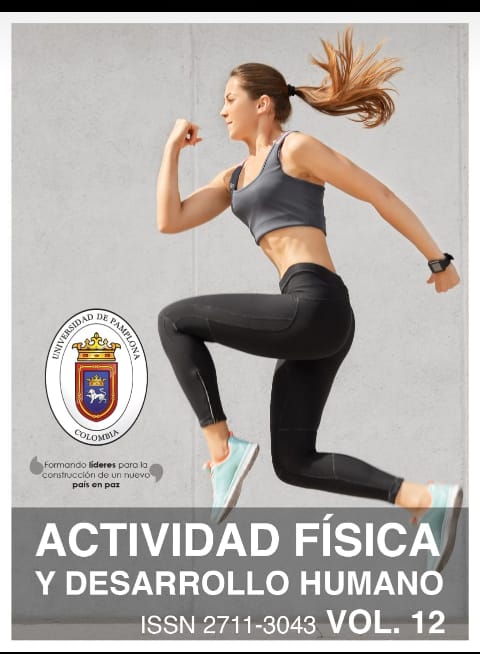Podoscopic and Stabilometric Analysis of a Martial Arts Athlete: A Case Study
DOI:
https://doi.org/10.24054/afdh.v12i1.1058Keywords:
Estabilometría, podometría, lesiones deportivas, biomecánicaAbstract
Introduction: Wushu is a traditional Chinese martial art and, as a combat sport, involves physical contact, which can cause injuries and affect the athlete’s ability to perform specific sports gestures.
Objective: To determine the podometric and stabilometric characteristics of a Wushu athlete.
Methodology: Laboratory tests were conducted using a baropodometry platform to analyze stabilometry and podometry in a 19-year-old male martial arts practitioner, practicing since age 10 and Wushu since age 14. He was a national champion in 2016 and 2017 at the Colombian National Wushu Tournament, winning gold in both the combat modality and the Choy Lee Fut and Nanquan forms.
Results: In stabilometry, the Romberg index was 1.04. Baropodometry showed higher pressure in the right forefoot (maximum pressure 423 kPa) compared to the left forefoot (341 kPa). In dynamic stability, greater stability was observed with eyes closed, whereas greater sway amplitude and number of oscillations occurred with eyes open.
Conclusion: This case study contributes to the understanding of baropodometry and stabilometry in Wushu athletes under eyes-open and eyes-closed conditions, helping to establish guidelines for the prevention of sports injuries. Additionally, it provides biomechanical movement patterns aligned with the sport’s gestures, which can enhance performance when incorporated into training programs.
Downloads
References
Ageberg, E. Robert D, Holmtrom E, Frinden T. (2005). Balance in Single-Limb Stance in Patients With Anterior Cruciate Ligament Injury: Relation to Knee Laxity, Proprioception, Muscle Strength, and Subjective Function. J Sports Med; 33(10):1527-35. http://doi.org/10.1177/0363546505274934.
Almendariz-Pozo, PA; Bonifaz-Arias,IG; Alvarez-Zambonino, EE y Sánchez-Estrada, KG. (2019). La propiocepción, método de prevención de lesiones de tobillo, en deportistas de categoría superior. Rev Podium ;14 (3) .451-462.
Artioli, GG, Gualano, B, Franchini, E, Batista, RN, Polacow, VO, and Lancha, AH Jr. (2009). Physiological, performance, and nutritional profile of the Brazilian Olympic Wushu (kung-fu) team. J Strength Cond Res 23(1): 20-25. http://doi.org/10.1519/JSC.0b013e318187687a
Brigida P, Possamai F, Nascimento Júnior J, Jacob W, Oliveira D. (2016). Análise Comparativa do Equilíbrio Quase Estático entre Praticantes de Muay-Thai de Diferentes Níveis de Aprendizado. Saúde e Pesquisa ;9(2):211.
Gómez Salazar L. (2009). La biomecánica en la prevención de lesiones deportivas. 7º Seminario Internacional de Entrenamiento Deportivo. Expomotricidad.
Gómez Salazar, L.; Franco Alvarez, J.; Nathy Portilla, J.; Valencia Esguerra, E.; Vargas Bonilla, D.; Jiménez Hernández, L. (2010). Características De La Huella Plantar En Deportistas Colombianos. entramado; 6, 158-167.
Guimaraes-Ribeiro, D., Hernández-Suárez, M., Rodríguez-Ruiz, D., & García-Manso, J. M. (2015). Efecto del entrenamiento sistemático de gimnasia rítmica sobre el control postural de niñas adolescentes. Revista Andaluza de Medicina Del Deporte; 8(2), 54–60. https://doi.org/10.1016/j.ramd.2015.02.004
Kuan, G, Roy, J. (2007). Goal Profiles, Mental Toughness and its Influence on Performance Outcomes among Wushu Athletes, J Sports Sci Med. 6(2): 28–33 PMC3809050
Martínez-Amat, A.; Hita-Contreras, F.; Ruiz-Ariza, A.; Muñoz-Jiménez, M.; Cruz-Díaz, D. y Martínez-López, E.J. (2016). Influencia de la práctica deportiva sobre la huella plantar en atletas españoles. Rev. Int. Med. Cienc. Act. Fís. Deporte;16 (62),423-438. http://doi.org/10.15366/rimcafd2016.63.002
Ortiz, F., Rincón, M., & Mendoza, J. C. (2016). Medicina Física y Rehabilitación. Editorial Manual Moderno. ISBN 13: 9789588993034
Pereira Silva, L. F. (2018). Estudo da influência de uma competição de Taekwondo sobre o equilíbrio estático e potência de membros inferiores. Monografia (Graduação Em Educação Física). https://doi.org/10.1017/CBO9781107415324.004
Verdezoto Cabrera T, Villacis Angara J. (2020). Comparación del tipo de pisada en los jugadores del club Sociedad Deportiva Aucas, los practicantes de taekwondo del Club de Artes Marciales Universitario y el club de atletismo de la Concentración Deportiva de Pichincha durante el periodo octubre 2019 – febrero 2020
Villaquirán Hurtado, A. (2019). Postura y huella plantar en deportistas de combate (taekwondo y karate). Revista De Investigación E Innovación En Ciencias De La Salud ;1(1), 41-50.
Zafra Duquea P, Berna Gascón, JA, (2014). Análisis de la presión plantar entre el pie dominante y no dominante en jugadores de futbol profesional. Therapeia.; 45-57.
Zurita Ortega, F., Martínez Martínez, A., & Zurita Ortega, A. (2007). Influencia de la tipología del pie en la actividad físico deportiva. Fisioterapia; 29(2), 74–79. http://doi.org/10.1016/S02115638(07)74417-6
Downloads
Published
Issue
Section
License
Copyright (c) 2021 ACTIVIDAD FÍSICA Y DESARROLLO HUMANO

This work is licensed under a Creative Commons Attribution-NonCommercial-NoDerivatives 4.0 International License.











